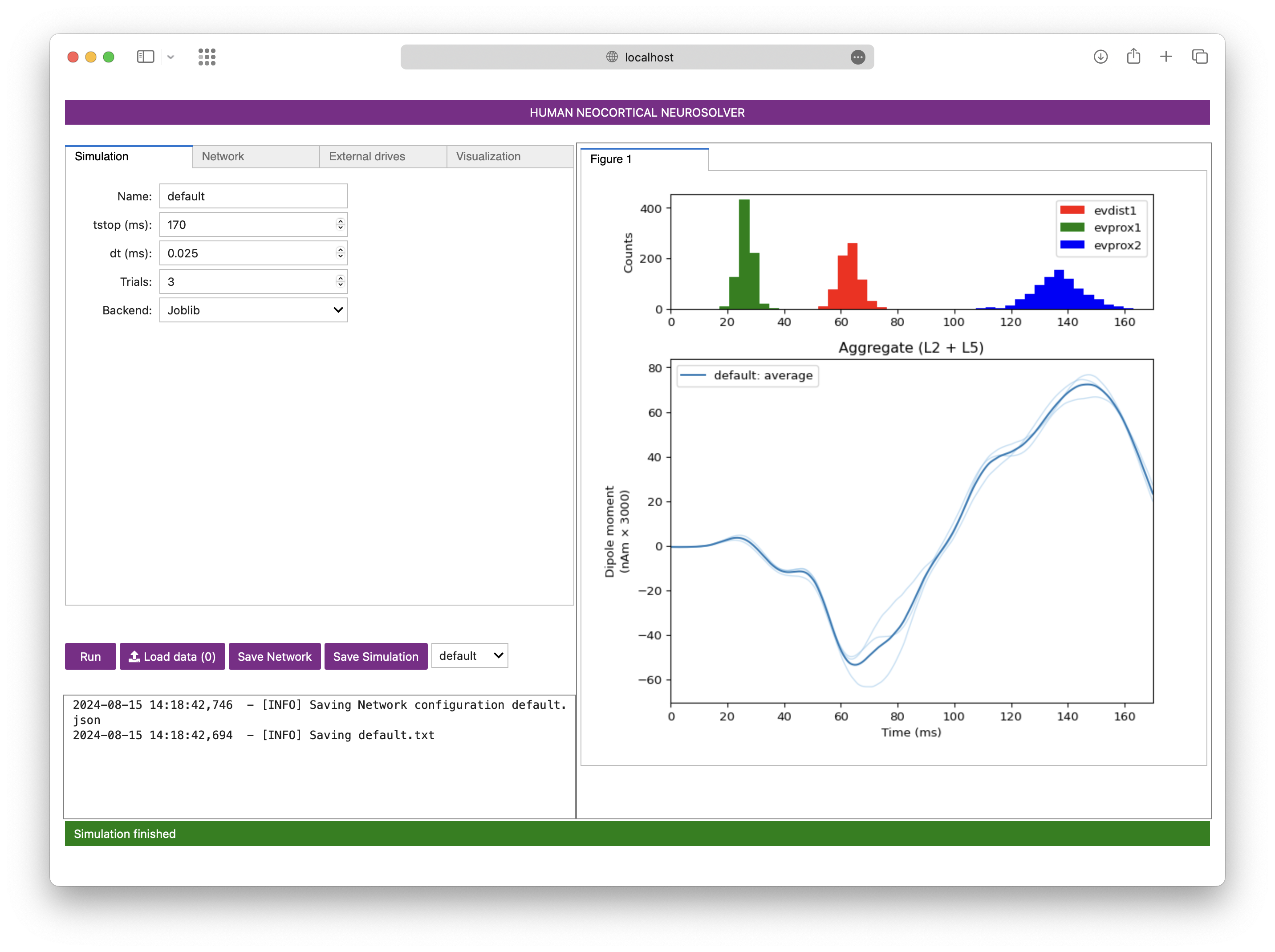This is a leaner and cleaner version of the code based off the HNN repository.
The Human Neocortical Neurosolver (HNN) is an open-source neural modeling tool designed to help researchers/clinicians interpret human brain imaging data. Based off the original HNN repository, HNN-core provides a convenient way to run simulations of an anatomically and biophysically detailed dynamical system model of human thalamocortical brain circuits with only a few lines of code. Given its modular, object-oriented design, HNN-core makes it easy to generate and evaluate hypotheses on the mechanistic origin of signals measured with magnetoencephalography (MEG), electroencephalography (EEG), or intracranial electrocorticography (ECoG). A unique feature of the HNN model is that it accounts for the biophysics generating the primary electric currents underlying such data, so simulation results are directly comparable to source localized data (current dipoles in units of nano-Ampere-meters); this enables precise tuning of model parameters to match characteristics of recorded signals. Multimodal neurophysiology data such as local field potential (LFP), current-source density (CSD), and spiking dynamics can also be simulated simultaneously with current dipoles.
While the HNN-core API is designed to be flexible and serve users with varying levels of coding expertise, the HNN-core GUI is designed to be useful to researchers with no formal computational neural modeling or coding experience.
For more information visit https://hnn.brown.edu. There, we describe the use of HNN in studying the circuit-level origin of some of the most commonly measured MEG/EEG and ECoG signals: event related potentials (ERPs) and low frequency rhythms (alpha/beta/gamma).
Contributors are very welcome. Please read our contributing guide if you are interested.
hnn-core requires Python (>=3.8) and the following packages:
- numpy
- scipy
- matplotlib
- Neuron (>=7.7)
- ipywidgets
- voila
- ipympl
- ipykernel
Note: Please follow the GUI installation section to install the correct GUI dependency versions automatically.
- scikit-learn
- joblib (for simulating trials simultaneously)
- mpi4py (for simulating the cells in parallel for a single trial).
Also depends on:
- openmpi or other mpi platform installed on system
- psutil
We recommend the Anaconda Python
distribution. To install
hnn-core, simply do:
$ pip install hnn_core
and it will install hnn-core along with the dependencies which are not
already installed.
Note that if you installed Neuron using the traditional installer
package, it is recommended to remove it first and unset PYTHONPATH and
PYTHONHOME if they were set. This is because the pip installer works
better with virtual environments such as the ones provided by conda.
If you want to track the latest developments of hnn-core, you can
install the current version of the code (nightly) with:
$ pip install --upgrade https://api.github.com/repos/jonescompneurolab/hnn-core/zipball/master
To check if everything worked fine, you can do:
$ python -c 'import hnn_core'
and it should not give any error messages.
Installing optimization dependencies
If you are using bayesian optimization, then scikit-learn is required. Install hnn-core with scikit-learn using the following command:
$ pip install hnn_core[opt]
GUI installation
To install the GUI dependencies along with hnn-core, a simple tweak to
the above command is needed:
$ pip install hnn_core[gui]
Note if you are zsh in macOS the command is:
$ pip install hnn_core'[gui]'
To start the GUI, please do:
$ hnn-gui
Parallel backends
For further instructions on installation and usage of parallel backends for using more than one CPU core, refer to our parallel backend guide.
Note for Windows users
Install Neuron using the precompiled
installers before installing
hnn-core. Make sure that:
$ python -c 'import neuron;'
does not throw any errors before running the install command. If you encounter errors, please get help from NEURON forum. Finally, do:
$ pip install hnn_core[gui]
Once you have tested that hnn_core and its dependencies were
installed, we recommend downloading and executing the example
scripts
provided on the documentation
pages (as well as in the
GitHub repository).
Note that python plots are by default non-interactive (blocking): each
plot must thus be closed before the code execution continues. We
recommend using and 'interactive' python interpreter such as
ipython:
$ ipython --matplotlib
and executing the scripts using the %run-magic:
%run plot_simulate_evoked.py
When executed in this manner, the scripts will execute entirely, after which all plots will be shown. For an even more interactive experience, in which you execute code and interrogate plots in sequential blocks, we recommend editors such as VS Code and Spyder.
Use the github issue tracker to report bugs. For user questions and scientific discussions, please see our GitHub Discussions page.
Read our contributing guide.
Read our governance structure.
If you use HNN-core in your work, please cite our publication in JOSS:
Jas et al., (2023). HNN-core: A Python software for cellular and circuit-level interpretation of human MEG/EEG. Journal of Open Source Software, 8(92), 5848, https://doi.org/10.21105/joss.05848

